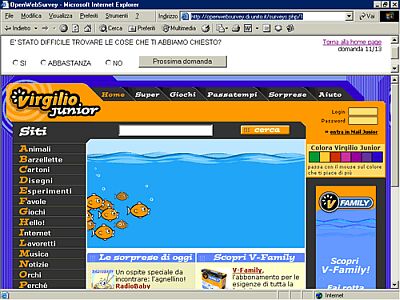
Remote web usability testing
V. Lanfranchi and A. Baravalle
Informatics, University of Turin, Turin, Italy
Remote usability testing allows researchers to evaluate the usability of web sites by gathering information from remote users [1]. In this paper, we describe a software package, called OpenWebSurvey, capable of recording, storing, sharing and processing data for web usability analysis. An alpha release of the software is being tested at Turin University, Department of Information Technology, to investigate the usability of web sites for children.
Problems in usability testing
Although it is common to run usability tests in research laboratories, there are some situations in which this is not possible, because it is difficult to find a sufficient number of users willing (or able) to participate. In these situations, it can be useful to record user behavior remotely. Moreover, instead of simply supplying a survey to collect information about the perceived usability of a site, it is also useful to have quantitative data about user behavior while surfing. OpenWebSurvey allows you to do this without needing to install any software or hardware components, either in the client computer or on the web site server.
Testing model
OpenWebSurvey is a web-based survey software package. This means that the user
connects to the OpenWebSurvey server, surfs a site under investigation and answers
some questions. The testing interface is a double-framed browser window (Figure
1): the upper frame contains the survey questions and input fields to be completed,
while the lower frame contains the site under investigation, modified to allow
surfing data to be recorded.

Figure 1. OpenWebSurvey's testing interface.
Although users do not perceive any differences when surfing the site under investigation, OpenWebSurvey monitors their web navigation and stores data about the pages visited (load times, client side actions), the entire user session (pages visited, total visit time, page visit time, general information about the user system) and the survey answers. On the server side, it tracks and saves user navigation data; on the client side, it tries to capture every step of user interaction with the system (i.e. mouse movements and actions).
Survey questions and answers and other collected data are stored in XML format [2], and functions are provided to easily import and export them. In the analysis stage, researchers can make assumptions about site usability and infer psychological motivations that may have induced certain actions, using the data collected on survey answers and user behavior.
The usefulness of OpenWebSurvey is maximised if it is used with survey questions that involve performing tasks, such as looking for an answer in a web site. In this way, it is possible to analyse not only the answer found by the user, but also how (s)he discovered it.
References
Paper presented at Measuring Behavior 2002 , 4th International Conference on Methods and Techniques in Behavioral Research, 27-30 August 2002, Amsterdam, The Netherlands